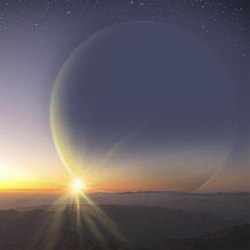PH2, also known as Kepler-86,[1] or KIC 12735740 (2MASS J19190326+5157453), is a G-type star[8][note 1] 1,120 light-years (340 parsecs) distant[4] within the constellation Cygnus.[3] Roughly the size and temperature[6] of the Sun,[10] PH2 gained prominence when it was known to be the host of one of 42 planet candidates detected by the Planet Hunters citizen science project in its second data release.[11] The candidate orbiting around PH2, known as PH2b, had been determined to have a spurious detection probability of only 0.08%, thus effectively confirming its existence as a planet.[8]
Located in its parent star's habitable zone, PH2b (or Kepler-86b[1]) is a Jupiter-size gas giant which could in theory host a natural satellite suitable for hosting life.[11] The report of the confirmed detection of PH2b was submitted on January 3, 2013.[8] It was discovered by amateur Pole Rafał Herszkowicz using his laptop and access to the Internet project with data from the Kepler space observatory.[12]
- ^ a b c Cite error: The named reference
NASA-20130925was invoked but never defined (see the help page). - ^ a b c d e f Cite error: The named reference
2MASSwas invoked but never defined (see the help page). - ^ a b Cite error: The named reference
vizierwas invoked but never defined (see the help page). - ^ a b c d e f Cite error: The named reference
GaiaDR3was invoked but never defined (see the help page). - ^ a b Cite error: The named reference
Dubber2019was invoked but never defined (see the help page). - ^ a b c Cite error: The named reference
KICwas invoked but never defined (see the help page). - ^ Cite error: The named reference
mamajek-2012was invoked but never defined (see the help page). - ^ a b c d e Cite error: The named reference
wang-2013was invoked but never defined (see the help page). - ^ Cite error: The named reference
SIMBADwas invoked but never defined (see the help page). - ^ Cite error: The named reference
sunfactsheetwas invoked but never defined (see the help page). - ^ a b Cite error: The named reference
howell-2013was invoked but never defined (see the help page). - ^ "Polski informatyk Rafał Herszkowicz odkrył nową planete PH2b | Forsal.pl - Giełda, Waluty, Finanse" (in Polish). Forsal. 2013-03-27. Retrieved 2013-07-12.
Cite error: There are <ref group=note> tags on this page, but the references will not show without a {{reflist|group=note}} template (see the help page).
